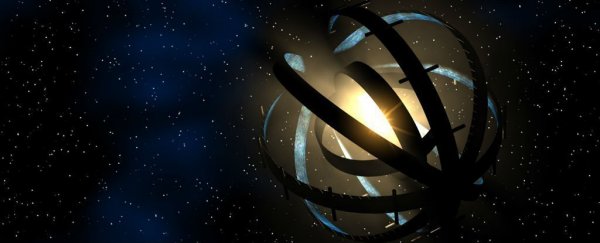Back in October, astronomers discovered a strange pattern of light near a distant star called KIC 8462852 that no one could explain. When a planet orbits a star, the star's brightness will usually dip by just 1 percent, but KIC 8462852 has been experiencing dips of up to 22 percent, which suggests that something very, very big is zooming past.
The best explanation we had was that a huge mass of comets has been erratically orbiting KIC 8462852, kicking up enough dust to dim its light to such a degree. But a new analysis of the last 100 years of the star's history has rendered this hypothesis just as implausible as any other. So… aliens then?
"Either one of our refutations has some hidden loophole, or some theorist needs to come up with some other proposal," astronomer Bradley Schaefer from Louisiana State University told Jacob Aron at New Scientist.
When KIC 8462852's bizarre light patterns were announced last year, the team behind the discovery offered up what scientists have considered the most plausible explanation. We described the situation in October:
"The best explanation we have is that at one point, another star passed into KIC 8462852's system and the disturbance of gravity caused a huge mass of comets to be pulled in towards it before being expelled again. And there just so happens to be another star close enough to KIC 8462852 to make this a possibility."
Based on what we knew about the star, the explanation made sense, theoretically, but it was an incredibly long shot. Not as unlikely as a light-harvesting alien megastructure called a Dyson Sphere, ripped straight out of science fiction by astronomers from Pennsylvania State University a month later, but the chances of us witnessing such an event were super thin.
"[It] would be an extraordinary coincidence, if that happened so recently, only a few millennia before humans developed the tech to loft a telescope into space. That's a narrow band of time, cosmically speaking," Ross Andersen reported for The Atlantic at the time.
So what's wrong with the comet swarm hypothesis?
When astronomer Tabetha Boyajian from Yale University and her colleagues first discovered that KIC 8462852 was giving off weird light patterns between 2009 and 2013, they checked 100 years worth of photographic plates held by the Harvard University archive to see if something similar had occurred around the star many years before. They come up with nothing.
Schaefer and his team from Louisiana State decided to check the data again using a different method of analysis, and noticed that the star dimmed very gradually by about 20 percent between 1890 and 1989. "The basic effect is small and not obvious," he told New Scientist.
Schaefer concluded that for the star to dim by about 20 percent over the course of an entire century, it would require some 648,000 comets - each about 200 kilometres wide - to have transited KIC 8462852, and that's completely implausible, he said. "The comet-family idea was reasonably put forth as the best of the proposals, even while acknowledging that they all were a poor lot. But now we have a refutation of the idea, and indeed, of all published ideas."
So we're back to the drawing board, and this time we don't even have any remotely plausible explanations for wtf is going on with KIC 8462852.
Despite Schaefer insisting that a light-harvesting Dyson Sphere would be radiating heat that hasn't appeared in infrared signals recorded from the star, the whole "Aliens…?!" thing is still probably going to follow KIC 8462852 to its grave.
But that's no big deal, because what's even cooler than the aliens non-event is the fact that we've got a front row seat to the scientific method in action, and what's more awesome than watching scientists try to explain possibly the weirdest star ever discovered? We can't wait to see what the next chapter of this story is going to be.
Schaefer's analysis has been published on the pre-print website, arXiv.org.
